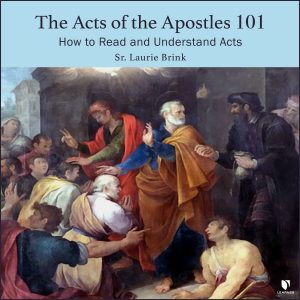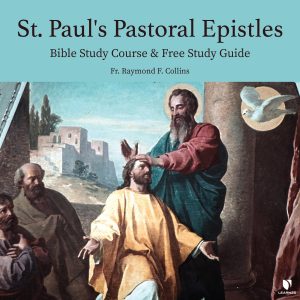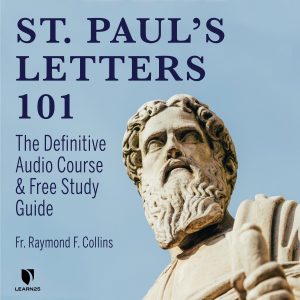What can the letters of Paul, the earliest Christian writings, teach you about living virtuously today?
The virtues of faith, hope, and love, first articulated by St. Paul in 1 Thessalonians, have come to epitomize the Christian life. So often repeated, these words are frequently misunderstood. As you will come to discover, Paul actually intended them as a call to live out a radical spirituality in the footsteps of Jesus Christ.
In this inspiring course from renowned Pauline expert Fr. Raymond Collins, S.T.D., you will focus on three of Paul’s epistles—First Thessalonians and his two letters to the Corinthians—to see how Paul leads you to follow Christ today. As you enjoy these lectures, available on audio and video, you will witness the development of the early Church, which has much to teach us in our own time.
From the perspective of twenty-first century believers, these letters are particularly fascinating, as they reveal churches filled with real people and real issues. Tackling issues such as sexual morality, death, and money, Paul’s letters are as relevant today as ever.
Along the way, Fr. Collins will
What can the letters of Paul, the earliest Christian writings, teach you about living virtuously today?
The virtues of faith, hope, and love, first articulated by St. Paul in 1 Thessalonians, have come to epitomize the Christian life. So often repeated, these words are frequently misunderstood. As you will come to discover, Paul actually intended them as a call to live out a radical spirituality in the footsteps of Jesus Christ.
In this inspiring course from renowned Pauline expert Fr. Raymond Collins, S.T.D., you will focus on three of Paul’s epistles—First Thessalonians and his two letters to the Corinthians—to see how Paul leads you to follow Christ today. As you enjoy these lectures, available on audio and video, you will witness the development of the early Church, which has much to teach us in our own time.
From the perspective of twenty-first century believers, these letters are particularly fascinating, as they reveal churches filled with real people and real issues. Tackling issues such as sexual morality, death, and money, Paul’s letters are as relevant today as ever.
Along the way, Fr. Collins will provide you with an in-depth study of the lexicon and historical context of the letters. With such a masterful scholar as your guide, you will come to understand Scripture as never before.
Learn about downloadable programs.
Your Free Electronic Study Guide! When you order this course, we will send you a free electronic study guide that you can access in 3 convenient ways:
1) You can check your order confirmation email. It will include a link that enables you to download your guide.
2) The back of your program package also contains a copy of this link. You can access your guide by simply entering this URL into your browser.
3) Your case of CDs or DVDs will contain a copy of your electronic guide on CD. Simply insert this disc into your computer’s CD/DVD drive to access your guide.
$23.99




You must be logged in to post a review.
© 2021 Learn 25 | Privacy Policy | Terms of Use | MP3 Downloads | Customer Support
Stay in the know.
Enter your email address for a free coupon, and to find out about future specials and promotions. You may unsubscribe at any time.


In an effort to provide our customers the best possible experience, we have created a new website for you at Learn25.com to browse our selection of over 400 audio and video courses by top professors.
Andrea Lorenzo –
Excellent Teaching by an World-Class Expert on Paul
In 1992, I was in the midst of my Ph.D. program at Marquette University. An important respite I had from the endless hours of study was Milwaukee County Stadium (now since torn down and replaced by Miller Park). My wife and I would scrape together whatever spare change we could find, pack some sandwiches and chips and fork over the $4 per ticket to sit out in the bleachers and watch our beloved Milwaukee Brewers.
I remember well July 21, 1992. I had heard that Nolan Ryan, the famous strikeout artist (5,714 career strikeouts!), was going to pitch. I was determined not to miss this chance to see a living legend. Ryan was in his twenty-sixth year (of twenty-seven) in the Major Leagues. By baseball standards, he was already a Hall of Famer. I wanted to know what such a man looked like in person.
I was not disappointed. As I noted earlier, I sat in the bleachers. I made a point to arrive early because I planned to watch Ryan warm up in the bullpen. I sat near the fence in right field, only a few feet away as this legend strode to the practice mound, right below me in the visitors’ bullpen. After a few obligatory soft throws, Ryan began to bring the heat. By “heat” let me note by way of explanation that on the very last day of Ryan’s career (September 22, 1993), he tore a ligament in his throwing arm while pitching against Seattle. After sustaining this injury he tried to soldier on, throwing one final pitch. This last pitch, torn ligament and all, was clocked at 98 miles per hour!
I remember the sound of the ball as it struck the catcher’s mitt. The catcher was facing me in the bullpen, perhaps just over a hundred feet away. Each pitch smashed into the glove, cracking like a gunshot. Further, there is a very unique sound a baseball makes when it is thrown at a high velocity, a sizzling noise that is truly intimidating.
Yet, for all the fireworks that Ryan’s speed provided, what really stood out to me was the sheer poetry of his pitching motion. Mind you, Ryan was forty-five years old at the time I saw him. Yet, as part of his delivery to the plate, he was able to lift his front leg so that his knee came very close to his face! What is more, when he uncoiled and his body hurled itself at the plate, his motion was like water, flowing unimpeded as a mighty torrent. There was no wasted motion, no hesitation, nothing but this single-minded waterfall of speed and power that rushed upon the batter, threatening to wash him away.
Ryan went on to pitch 6.2 innings that day. He struck out four, gave up seven hits, two walks, and two runs, one earned. He left the game without a decision; although the Rangers went on to win 6 to 3. It was not, by his standards, a particularly memorable day.
Yet, I have never forgotten what I witnessed. You know greatness when you see it.
My first experience of Fr. Raymond F. Collins was in the summer of 1989. I was beginning my M.A. in Biblical Studies at Providence College. Collins was home in Rhode Island visiting his mother, on summer break from his duties at the Katholieke Universiteit Leuven. He had been asked to teach a summer course in the Pastoral Epistles which I was fortunate enough to take. Right away, it was clear to me that Collins was a brilliant teacher, animated, humorous and easy to follow. I eagerly anticipated each class, soaking up as much as I was able. What is more, I found that Collins was extremely personable, essentially a man devoid of pretense, a people’s priest. Virtually every day, we (my fellow students and I) had lunch with him in the cafeteria. I marveled that not only was Collins a fine biblical scholar, able to answer the most detailed questions on the Greek text, but he was also a great person, just as capable of discussing music or college football. He was a man fully engaged in life. This engagement made and still makes him a great teacher and preacher/pastor because he was/ is no disembodied intellect, living in an ivory tower. I knew that I wanted to be just like him.
Twenty six years have passed since that summer in 1989 and it is perfectly clear to me that Fr. Raymond Collins has lost nothing off his teaching ‘fastball!’
His audio/ video course for NYKM, First Thessalonians and the Corinthian Correspondence: A Bible Study Course, is an excellent piece of work, capturing Collins at his teaching best. The course, consisting of eighteen lectures is broken up as follows: six lectures on 1 Thessalonians, six lectures on 1 Corinthians, five lectures on 2 Corinthians and one final lecture of Collins’ pastoral reflections on the three texts.
The first thing that struck me about the selection of these three texts for this course was the fact that Collins was very well-qualified to address each one. In 1990, The New Jerome Biblical Commentary, edited by R. E. Brown, J. A. Fitzmeyer, and R. E. Murphy (Englewood Cliffs, N.J.: Prentice-Hall, 1990), was published. This single-volume commentary reflected the crème de la crème of modern Catholic biblical scholarship and Collins was asked to write the article on 1 Thessalonians! This indicates that even then, some twenty-five years ago, Collins was regarded as an expert on the letter. Likewise, in 2006, Collins wrote an excellent tome (over 700 pages!) on 1 Corinthians as part of Liturgical Press’ famous Sacra Pagina Series. Finally, in 2013, Collins wrote a commentary on 2 Corinthians for Baker Academic as part of their highly-regarded Paideia Commentaries on the New Testament Series. This is to say nothing of the many articles and other books Collins has produced that explore various themes addressed in these letters. Simply stated, studying these three Pauline epistles with Collins is like getting Nolan Ryan to coach your little leaguer on the finer points of the fastball. You just can’t do better, not on this side of heaven.
As noted before, the first six lectures address 1 Thessalonians, believed by most New Testament scholars to be the first extant Christian writing. In Lecture 1, Collins expresses the human side to Paul’s writing of 1 Thessalonians in his usual charming manner, “So there we are. Lonely people. Wanting to get in touch with the Thessalonians. Don’t have a telephone. So what do you do? You write them a letter. And in doing so, Paul began the New Testament.”
Collins is very aware of the human, pastoral situation faced by Paul’s fledgling church in Thessalonica. The church, hemmed in by a world that did not accept them and which actively persecuted them (1 Thes 2:14), had to band together, recognizing Paul’s affection for them (Lecture 3), and overcome their “missing hope” (see Lecture 5) and confusion over the fate of those believers who have died before the Day of the Lord (1 Thes 4:13-5:11).
As is Collins’ way, he explains Paul’s lofty vision of communal love, challenging us to rethink our conceptions of Church. This is well-illustrated by Collins’ discussion of 1 Thes 5:13b-15 in Lecture 6: “So his general instruction to the community is that they be at peace with one another. But for Paul that concept of peace was not simply a matter of not having any disputes. For Paul, the concept of peace, the shalom or eirene of the Hebrew tradition was that they should be looking to the well-being of one another. We are at peace with one another, not only when we don’t get into a fight, but when we are looking out for one another in a very positive way, a helpful way. ‘Is there anything I can do for my neighbor?’ That’s the kind of community that Paul expects the Thessalonian believers to have.”
The second six lectures (Lectures 7-12), address 1 Corinthians, a letter Collins describes as a text that “lets us see what a real-life community looks like” (Lecture 7). Of special note here is Lecture 8, which addresses Paul’s use of various metaphors to express spiritual truths (e.g., the agricultural imagery he employs, his architectural language, and his athletic comparisons). Of course, this is familiar ground for Collins who has devoted an entire book to this very topic (i.e., The Power of Images in Paul [Collegeville, Minn.: Liturgical, 2008]).
Likewise, Lecture 9 addresses the various problems current in Corinth’s churches related to sexuality. Once again, Collins’ lectures are informed by long study of these issues, reflected in two major books, Accompanied by a Believing Wife: Ministry and Celibacy in Earliest Christian Communities (Collegeville, Minn.: Liturgical, 2013); and Sexual Ethics and the New Testament: Behavior and Belief (Companions to the New Testament; New York: Crossroad, 2000). The result is a coherent and realistic discussion of these serious problems.
Throughout these lectures, Collins’ lectures are informed not only by his own insights (which are many and well supported) but also by a thoroughgoing acquaintance with the larger scholarly community’s discussions of Paul and his letters. There are times when Collins mentions a particular scholar such as Abraham Malherbe in Lecture 3 (known for his close comparison study of Paul and the Greek philosophical tradition) and Hans Dieter Betz in Lecture 13 (known for his theory of the composite character of 2 Corinthians). However, more often than not, Collins’ lectures are informed and shaped by the larger contributions of his friends and colleagues in a way that does not bog down his presentation with too many scholarly citations. Nowhere is this better exemplified than in Lecture 10 and his discussion of the communal meal (eranos) and Eucharistic celebration in 1 Cor 11. The informed scholar hears the contributions of Gerd Theissen and Jerome Murphy O’Connor, who both made monumental contributions to this discussion. Yet, the listener is afforded the benefits of these insights in a way that is easy to absorb.
The discussion of 1 Corinthians is brought to a conclusion (sadly, as I would have wished for more!) by Lecture 12, which addresses the question of resurrection. Again, Collins’ discussion is insightful, unpacking the underlying creedal formulae that are present in 1 Cor 15:1-7 and continuing on to address Paul’s refutation of “those who say that there is no resurrection of the dead (1 Cor 15:12-34). This is an excellent lecture and, my only criticism is that it left me wanting a deeper, fuller treatment of the material. Alas, this is not the place for such a discussion as Collins is constrained by space and time. Yet, the lecture is very effective it that it provokes its hearer to want more.
Lectures 13 to 17 deal with 2 Corinthians and, I must admit, were my least favorite part of the course. This is not because Collins falters in the quality of his teaching. Rather, 2 Corinthians always leaves me with a certain hollow feeling, revealing as it does the many human faults and failings of the Church.
Collins uses Lecture 13 to explain the reasons why that many scholars view 2 Corinthians as a composite of several pre-existing Pauline letters. He discusses in depth an example of one such theory, that of Hans Dieter Betz, who posits six original parts, five Pauline letters and a non-Pauline addition (namely 6:14-7:1). After outlining this theory, Collins begins to interpret 2 Corinthians, drawing on these insights to retell the story of Paul’s interactions with the Corinthian faithful.
My favorites of these final lectures were Lecture 14 and Lecture 16. Lecture 14 contains a very good discussion of the emotional roller-coaster experienced by Paul and his companion, Titus, and even the Corinthians themselves. This ‘roller-coaster’ was a result of the clashes between Paul and some of the Corinthian faithful during his second visit and the impact of his subsequent “tearful letter” (2 Cor 2:1-4) and Titus’ eventual visit.
Lecture 16 is a very thought-provoking treatment of 2 Corinthians 8-9, what Hans Dieter Betz called the two “administrative letters.” Collins provides a very intriguing exploration of the various rhetorical devices used by Paul in these two letters to persuade, cajole, and compel the Corinthians to participate in a charitable collection for the poor in the Jerusalem church.
In listening to the lengths that Paul has to go so as to persuade his churches to contribute, I am struck with how hard Paul has to work to motivate his audience. Here is the “founder” of their faith and he lacks the communal authority to say, “Listen, my children, Christians are in need. Let’s act.” Rather, like a modern marketing guru selling some “innovative” product on late night television, he is forced into a hard sell. Clearly, this speaks volumes as to the damage done and the strained state of this ecclesial relationship.
Finally, Collins concludes with a Lecture 18, devoted entirely to practical, pastoral reflections on these three letters. For example, Collins recalls the socio-economic disparities and the abuses reflected in the Corinthian Eucharistic celebration and goes on to address the ongoing socio-economic inequities in society at large and their continued reality in the Church itself. His comments might be controversial for some but are perfectly in line with Pope Francis and the Gospel itself.
Collins final words are important, “Paul’s message in all three of these letters is not one that translates immediately into the circumstances of today. But there are analogies. And if we look for the analogy, we find that those ancient letters, written 2,000 years ago, constitute quite a big challenge. For we seem to be comfortable in this 21st century.”
As I said, Collins has lost nothing off his teaching fastball. You know greatness when you see it.